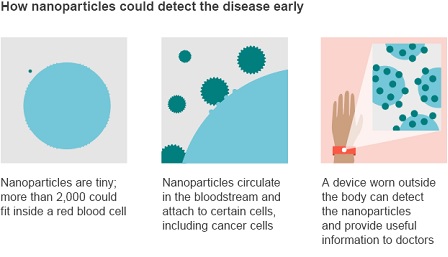Google is working on a new cancer detection system that uses pills and a smart wristband to detect early signs of the disease.
Watch this video from the Wall Street Journal discussing the project here:
Under development at Google’s X labs department, the pill would contain magnetic nanoparticles that travel through the bloodstream and search for early signs of disease, before being detected by a wearable wristband.
Google claims the technology would mean that cancer and heart disease patients to be diagnosed and treated far earlier that they are currently.
Nanoparticles could be ingested in a pill to enter the bloodstream, designed to bind to a particular type of cell – like a cancer tumor cell. This would be done by ‘painting’ them with a substance that could interact with the surface of cells and travel together as a unit through the bloodstream.

The core of the nanoparticles would be magnetic, so a wearable device that creates a magnetic field could draw the particles – with their target cells in tow – toward it, where they could be detected and counted.
Experts at Google are studying various non-invasive techniques, like light and radio waves, for detecting and counting the particles.
“Much of the improvement in cancer survival rates over the last 30 years is due to earlier detection, like skin cancer screening and Pap smears,” Google said. “Yet for many serious diseases, there still aren’t good enough diagnostics to help doctors catch them in their earliest stages, when they’re most treatable. ‘Pancreatic cancer is famously elusive, with only three per cent of cases found in the first, most curable stage. And some lung cancer tumours are so aggressive that they even kill people who go for annual CT screening, growing deadly in less than 12 months.”
Google’s engineers hope to harness the chemical signals given off by cells as they become diseased.
“We wondered: could continuous measurement of subtle changes in the chemistry of the blood be a way to detect a disease very early, when it’s most treatable?”
The reality is likely more than five years off, industry experts say, and faces huge challenges, both technical and social. Researchers have to identify coatings that will help the particles bind to specific cells. What’s more, Google doesn’t yet know how many nanoparticles would be needed for the system to work.
What’s more, the wearable device needs to be small enough to be unobtrusive but to accommodate a battery that doesn’t need frequent recharging.
The technology is being developed at Google’s X Lab, where work is also underway on smart contact lenses to monitor diabetes and special cutlery to eliminate the tremors of patients.
The initiative is part of Google’s broader efforts to expand beyond online advertising into new areas. Google X research lab is also working on self-driving cars, high-altitude balloons to deliver Internet and the Glass wearable computer.
The Google X Life Sciences team wants to harness data to make medicine more proactive, rather than reactive. Its Baseline study is building a detailed picture of a healthy human being, by genetically screening samples from thousands of people.
